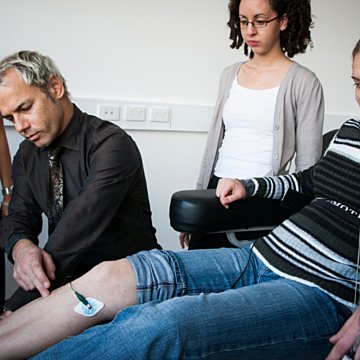Research Project

Daniel Boulton
Current Appointments
Conjoint Postdoctoral FellowDr Daniel Boulton is an early career researcher (PhD 2018) with a strong background in exercise physiology and neurophysiology. He is one of the most skilful microneurographers in Australia.
After receiving an Academic Excellence Scholarship (Western Sydney University/WSU), Dr Boulton was listed on the Dean's Merit List (Top 2% across the School of Science and Health, WSU). Following this, he was awarded both the University Medal and Dean's Medal for excellence in research and education for his achievements in his Honours and undergraduate degree (Sport and Exercise Science).
Dr Boulton works in the areas of neurophysiology, integrative physiology and neurological dysfunction in pain, fatigue, and exercise. Dr Boulton holds conjoint research and lecturing positions at the University of NSW and NeuRA and currently supervises two PhD students.
Dr Boulton has attracted grant funding worth approximately $1.64m from prestigious organisations. In 2023, he was chief investigator for a NHMRC Ideas Grant 2028446 to explore neurophysiological effects of sensory technology for balance rehabilitation. Another relevant successful grant source has been from The Mason Foundation, exploring the role of the metaboreflex in chronic fatigue syndrome (CFS).
Dr Boulton has developed original techniques and protocols to measure and analyse nerve activity, which is important for many innovative studies. Dr Boulton has become a renowned microneurographer, utilising innovative approaches to be the first to record nerve activity in CFS, one of only a few to directly record nerve activity to contracting muscle, and successfully carried out sympathetic nerve activity-fMRI coupled experiments to identify origins of sympathetic nerve activity in the brain, central dysfunction in hypertension, and chronic pain. He has applied this unique skillset within numerous projects and has substantial experience in assessing all types of nerve activity in healthy and clinical populations.
Publications
2019
A comparison of muscle sympathetic nerve activity to non-contracting muscle during isometric exercise in the upper and lower limbs
View full journal-article on http://www.scopus.com/inward/record.url?eid=2-s2.0-85068461596&partnerID=MN8TOARS
2019
Central command increases muscle sympathetic nerve activity more to contracting than noncontracting muscle during rhythmic isotonic leg exercise
View full journal-article on http://www.scopus.com/inward/record.url?eid=2-s2.0-85065327298&partnerID=MN8TOARS
2018
The metaboreflex does not contribute to the increase in muscle sympathetic nerve activity to contracting muscle during static exercise in humans
View full journal-article on http://www.scopus.com/inward/record.url?eid=2-s2.0-85043767505&partnerID=MN8TOARS
2015
Time course of muscle sympathetic nerve activity to active muscle during mild isometric contractions in humans
2014
Effect of contraction intensity on sympathetic nerve activity to active human skeletal muscle
2014
Effect of contraction intensity on sympathetic nerve activity to active human skeletal muscle
View full journal-article on http://www.scopus.com/inward/record.url?eid=2-s2.0-84904304873&partnerID=MN8TOARS

